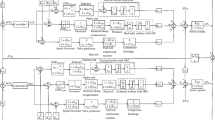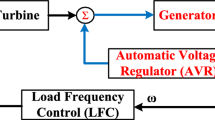Abstract
A new nonlinear H-infinity control approach is applied to PEM fuel cells. First, the dynamic model of the PEM fuel cells undergoes approximate linearisation, through Taylor series expansion, round local operating points which are defined at each time instant by the present value of the system’s state vector and the last value of the control input that was exerted on it. The linearisation procedure requires the computation of Jacobian matrices at the aforementioned operating points. The modelling error, which is due to the truncation of higher order terms in the Taylor series expansion is perceived as a perturbation that should be compensated by the robustness of the control loop. Next, for the linearized equivalent model of the PEM fuel cells, an H-infinity feedback control loop is designed. This approach, is based on the concept of a differential game that takes place between the control input (which tries to minimize the deviation of the state vector from the reference setpoints) and the disturbance input (that tries to maximize it). In such a case, the computation of the optimal control input requires the solution of an algebraic Riccati equation at each iteration of the control algorithm. The known robustness properties of H-infinity control enable compensation of model uncertainty and rejection of the perturbation terms that affect the PEM fuel cells system. The stability of the control loop is proven through Lyapunov analysis. Actually, it is shown that H-infinity tracking performance is succeeded, while conditionally the asymptotic stability of the control loop is also demonstrated. The efficiency of the proposed control scheme for the PEM fuel cells model is further confirmed through simulation experiments.

















Similar content being viewed by others
References
Na, W., Gou, B., Diong, B.: Nonlinear control of PEM fuel cells by exact linearization. IEEE Trans. Ind. Appl. 43(6), 1426–1433 (2007)
Na, W., Gou, B.: Feedback-linearization-based nonlinear control for PEM fuel cells. IEEE Trans. Energy Convers. 21(1), 179–190 (2008)
Schultz, M., Horn, J.: PEM fuel cell system power control based on a feedback-linearization approach. In: IEEE MED 2012, Meditteranean Conference on Control and Automation, Barcelona, Spain, July (2012)
Talj, R., Hissel, D., Ortega, R., Becherif, M., Hilairet, M.: Experimental validation of a PEM fuel-cell reduced-order model and a moto-compressor higher order sliding-mode control. IEEE Trans. Ind. Electron. 57(6), 1906–1913 (2010)
Ramos-Paja, C., Giral, R., Martinez-Salamero, L., Romano, J., Romero, A., Spagnuolo, G.: A PEM fuel-cell model featuring oxygen-excess-ratio estimation and power-electronics interaction. IEEE Trans. Ind. Electron. 57(6), 1914–1924 (2010)
da Costa Lopes, F., Watanabe, E.H., Rolim, L.: A control-oriented model of a PEM fuel cell stack based on NARX and NOE neural networks. IEEE Trans. Ind. Electron. 62(8), 5155–5163 (2015)
Valverde, L., Bordons, C., Rosa, F.: Integration of fuel cell technologies in renewable energy-based microgrids optimizing operational cost and durability. IEEE Trans. Ind. Electron. 63(1), 167–177 (2015)
Laghrouche, S., Liu, J., Ahmed, F., Harmouche, M., Wack, M.: Adaptive second-order sliding mode observer-based fault reconstruction for PEM fuel cell air-feed system. IEEE Trans. Control Syst. Technol. 23(3), 1098–1109 (2015)
Matraji, I., Laghrouche, S., Jemei, S., Wack, M.: Robust control of the PEM fuel cell air-feed system via sub-optimal second order sliding mode. Appl. Energy 104, 945–957 (2013)
Liu, J., Laghrouche, S., Wack, M.: Differential flatness-based observer desing for a PEM fuel cell using adaptive-gain sliding-mode differentiators, ECC 2013. In: 2013 European Control Conference, Zurich, Switzerland, July (2013)
Fang, C., Xu, L., Li, J., Ouyang, M.: Feedback linearizatio-based air pressure and mass flow regulation for PEMFC. In: IEEE SICE Annual Conference 2015, Hagzhou, China, July (2015)
Rodutz, S., Paganelli, G., Guzzella, L.: Optimizing air supply control of a PEM fuel cells system. In: Proceedings of IEEE American Control Conference, vol. 3, pp. 2043–2048
Lagrouche, S., Harmouche, M., Ahmed, F.S., Chitour, Y.: Control of PEMFC air-feed system using Lyapunov-based robust and adaptive higher order sliding-mode control. IEEE Trans. Control Syst. Technol. 21(4), 1594–1601 (2015)
Matraji, I., Lagrouche, S., Jemei, S., Wack, M.: Robust control of the PEM fuel cell air-feed system via sub-optimal second-order sliding-mode. Appl. Energy 104, 945–957 (2013)
Li, Q., Chen, W., Wang, Y.: Nonlinear robust control of proton exhange membrane fuel cell by state feedback exact linerization. J. Power Sources 124(1), 338–348 (2009)
Rigatos, G.: Modelling and Control for Intelligent Industrial Systems: Adaptive Algorithms in Robotics and Industrial Engineering. Springer, Berlin (2011)
Rigatos, G.: Advanced Models of Neural Networks: Nonlinear Dynamics and Stochasticity of Biological Neurons. Springer, Berlin (2013)
Rigatos, G.: Nonlinear Control and Filtering Approaches Using Differential Flatness Theory: Applications to Electromechanical Systems. Springer, Berlin (2015)
Rigatos, G.G., Tzafestas, S.G.: Extended Kalman filtering for fuzzy modelling and multi-sensor fusion. Math. Comput. Model. Dyn. Syst. 13, 251–266 (2007)
Bassevile, M., Nikiforov, I.: Detection of Abrupt Changes: Theory and Applications. Prentice-Hall, Upper Saddle River (1993)
Rigatos, G., Zhang, Q.: Fuzzy model validation using the local statistical approach. Fuzzy Sets Syst. 60(7), 882–904 (2009)
Doyle, J.C., Glover, K., Khargonekar, P.P., Francis, B.A.: State-space solutions to standard \(H_2\) and \(H_{\infty }\) control problems. IEEE Trans. Autom. Control 34, 831–847 (1989)
Kurylowicz, A., Jaworska, I., Tzafestas, S.G.: Robust stabilizing control : an overview. In: Tzafestas, S.G. (ed.) Applied Control: Current Trends and Modern Methodologies, pp. 289–324. Marcel Dekker, New York City (1993)
Lublin, L., Athans, M.: An experimental comparison of and designs for interferometer testbed. In: Francis, B., Tannenbaum, A. (eds.) Lectures Notes in Control and Information Sciences: Feedback Control, Nonlinear Systems and Complexity, pp. 150–172. Springer, Berlin (1995)
Ali, H.S., Boutat-Baddas, L., Becis-Aubry, Y., Darouach, M.: \(H_{\infty }\) control of a SCARA robot using polytopic LPV approach. In: IEEE MED 2006, 14th Mediterranean Conference on Control and Automation, Ancina, Italy (2006)
Stout, W.L., Sawan, M.E.: Application of H-infinity theory to robot manipulator control. In: First IEEE Conference on Control Applications, Dayton, Ohio, USA (1992)
Rigatos, G., Siano, P., Wira, P., Profumo, F.: Nonlinear H-infinity feedback control for asynchronous motors of electric trains. J. Intell. Ind. Syst. 1(2), 85–98 (2015)
Rigatos, G., Siano, P., Cecati, C.: A New Nonlinear H-Infinity Feedback Control Approach for Three-Phase Voltage Source Converters, Electric Power Compoments and Systems. Taylor and Francis, Oxfordshire (2015)
Toussaint, G., Basar, T., Bullo, F.: \(H_{\infty }\) optimal tracking control techniques for nonlinear underactuated Systems. In: Proceedings of the 39th IEEE Conference on Decision and Control Sydney, Australia December (2000)
Raffo, G.V., Ortega, M.G., Rubio, F.R.: Nonlinear H-infinity controller for the quad-rotor helicopter with input coupling. In: 18th World Congress of the IFAC, 2011, Milan, Italy, Aug (2011)
Raffo, G.V., Ortega, M.G., Rubio, F.R.: Path tracking of a UAV via an underactuated H-infinity control strategy. Eur. J. Control 17, 194–213 (2011)
Du, H., Zhang, N.: \(H_{\infty }\) control of active vehicle suspensions with actuator time delay. J. Sound Vib. 301, 236–252 (2007)
Yamashita, M., Fujimori, K., Hakayawa, K., Kimura, H.: Application of \(H_{\infty }\) control to active suspension systems. Automatica 30(11), 1717–1729 (1994)
Acknowledgements
Funding was provided by Unit of Industrial Automation / Industrial Systems Institute (Grant No. Ref 5585 / Intelligent Renewable Energy Systems).
Author information
Authors and Affiliations
Corresponding author
Rights and permissions
About this article
Cite this article
Rigatos, G., Siano, P., Wira, P. et al. A Nonlinear H-Infinity Approach to Optimal Control of PEM Fuel Cells. Intell Ind Syst 3, 43–58 (2017). https://doi.org/10.1007/s40903-017-0067-z
Received:
Revised:
Accepted:
Published:
Issue Date:
DOI: https://doi.org/10.1007/s40903-017-0067-z




